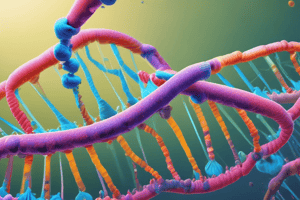Podcast
Questions and Answers
Flashcards are hidden until you start studying
Study Notes
DNA and Proteins
Introduction
Understanding the relationship between DNA and proteins is crucial for comprehending the fundamental biological mechanisms that govern life. DNA (deoxyribonucleic acid) carries the genetic information that controls the structure and function of all cells. Conversely, proteins are the functional components of the cell, performing various roles, such as enzymatic reactions, structural support, immune response, etc.
In this article, we will delve deeper into the intricate connection between DNA and proteins, discussing key concepts like genetics, protein synthesis, DNA replication, gene expression, and protein structure.
Genetics
Genetics is the study of hereditary traits and their transmission from parents to offspring. DNA plays a vital role in genetics by encoding the genetic material that determines the physical and behavioral characteristics of an organism. The genetic information stored in DNA is passed down from generation to generation, ensuring continuity across generations.
Protein Synthesis
Protein synthesis is the process by which the genetic information encoded in DNA is translated into functional proteins. It involves two main stages: transcription and translation.
Transcription
During the first stage, a single-stranded RNA (Ribonucleic Acid) molecule called messenger RNA (mRNA) is generated from a specific region of the double-stranded DNA known as a gene using an enzyme called RNA polymerase II. This process produces a pre-mRNA molecule, which is subsequently modified to form mature mRNA.
Translation
The mature mRNA molecule then travels to the cytoplasm, where it associates with ribosomes, specialized organelles involved in protein synthesis. The ribosomes consist of two subunits: the large (50S) and small (30S) subunit. The ribosome reads the genetic code contained within the mRNA molecule and synthesizes a protein using an adaptor molecule called transfer RNA (tRNA).
Transfer RNA (tRNA)
tRNA molecules carry amino acids to the ribosome and bind to specific codons (sequences of three nucleotides) in the mRNA molecule. Peptide bonds between adjacent amino acids are formed through a peptidyl transferase activity, which catalyzes the formation of polypeptide chains. After the protein chain is synthesized, it must be released from the ribosome by proteins called release factors.
DNA Replication
DNA replication is the process by which double-stranded DNA molecules are copied during cell division to form two identical daughter cells. This process ensures the accurate transmission of genetic information across generations.
Base Pairing
During replication, each strand of the double helix serves as a template for synthesis of a new complementary strand using nucleotides with nitrogenous bases: adenine (A), cytosine (C), guanine (G), and thymine (T) (or uracil, U, in RNA). Specific base pairing rules ensure that each strand pairs with its complementary strand, forming a double helix.
Gene Expression
Gene expression refers to the process by which the genetic information encoded in DNA is read out and turned into functional proteins. This process can be regulated at various levels, including transcription initiation, elongation, and termination, as well as post-transcriptional modifications.
Transcription Regulation
Transcription regulation involves controlling the rate at which genes are transcribed into RNA molecules. This can occur through the binding of regulatory proteins to specific sequences in the DNA molecule, altering the accessibility of RNA polymerase II to the gene's promoter region.
Post-Transcriptional Modifications
Post-transcriptional modifications involve changes to the RNA molecule after transcription but before translation. These modifications can include splicing, polyadenylation, and addition of modified nucleotides, which can affect the stability and translational efficiency of the mRNA molecule.
Protein Structure
Protein structure is crucial for understanding their function. Proteins have a complex and dynamic structure, often involving multiple domains and conformations. Understanding these structures allows scientists to predict the biological functions of newly discovered proteins.
Primary Structure
The primary structure of a protein consists of the sequence of amino acids determined by the genetic code carried by the protein's RNA transcript.
Secondary Structure
Secondary structures, such as alpha helices and beta sheets, arise from the hydrogen bonding between different regions of the same chain. They contribute to the overall stability of the protein molecule.
Tertiary Structure
Tertiary structures refer to the overall three-dimensional shape of the protein molecule. This complex structure is crucial for the protein's biological function.
Quaternary Structure
Quaternary structures involve multiple polypeptide chains folding together to form a larger functional unit. These higher levels of organization allow proteins to carry out more complex functions.
In conclusion, DNA and proteins play a central role in the functioning of cells. Genetics provides the genetic information necessary to synthesize proteins through processes like transcription and translation. Protein structure is crucial for understanding their function and biological activity. DNA replication ensures the faithful transmission of genetic information across generations, while gene expression allows cells to control protein production according to specific needs. Understanding these interconnected processes provides valuable insights into the complex machinery of life.
Studying That Suits You
Use AI to generate personalized quizzes and flashcards to suit your learning preferences.




